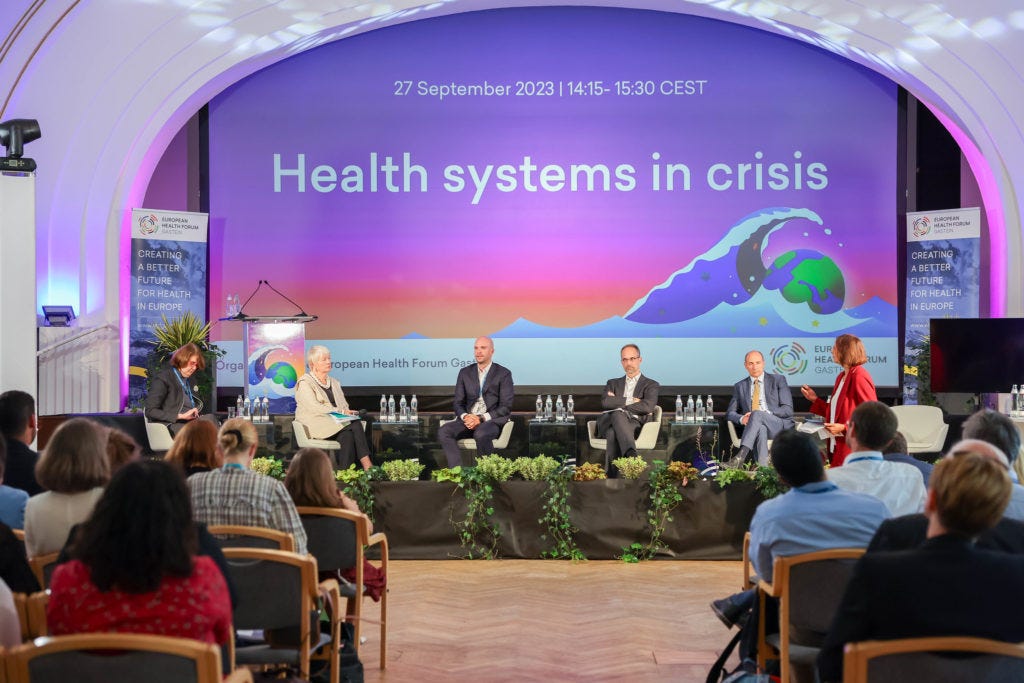the health strategist
institute for continuous transformation of health systems
from broken health systems
to world class health systems
Joaquim Cardoso MSc.
Founder and CEO
Education: Engineering, Administration, Technology
Experience: Researcher, Professor, Editor and Consultant (Senior Advisor)
What is the message?
Europe’s health systems are facing significant challenges that threaten their long-term stability.
These challenges include:
- Post-COVID Budget Crunch: European countries are grappling with budget constraints as they transition away from the COVID-19 pandemic. The leniency in budget spending during the pandemic is coming to an end, and governments are facing the prospect of significant cuts to public spending, with health budgets likely to be impacted.
- Ageing Population: Europe is experiencing a rapidly ageing population, which is increasing the demand for healthcare services. This demographic shift is putting pressure on health systems.
- Health Workforce Crisis: Despite having a substantial number of healthcare workers, Europe is facing a shortage of health professionals. Burnout, low pay, and hazardous working conditions are contributing to healthcare worker shortages, which could have severe consequences for the quality of care.
- Health as an Investment: Some experts and political leaders argue that health should be considered an investment rather than a cost against national budgets. They emphasize the need to prioritize health to maintain the quality and sustainability of Europe’s public health systems.
- Demographic Challenges: The article also highlights the challenges posed by Europe’s ageing doctors and the need to retain and motivate the existing healthcare workforce.
- Promoting Healthy Lifestyles: To address the long-term challenges, the article suggests that a focus on health literacy, education, awareness-raising, and policies that enable healthier lifestyles is necessary.
Europe’s healthcare systems, despite their reputation as well-funded and equitable, are under threat from multiple fronts, and addressing these challenges is crucial for maintaining the quality and accessibility of healthcare in the region.
DEEP DIVE
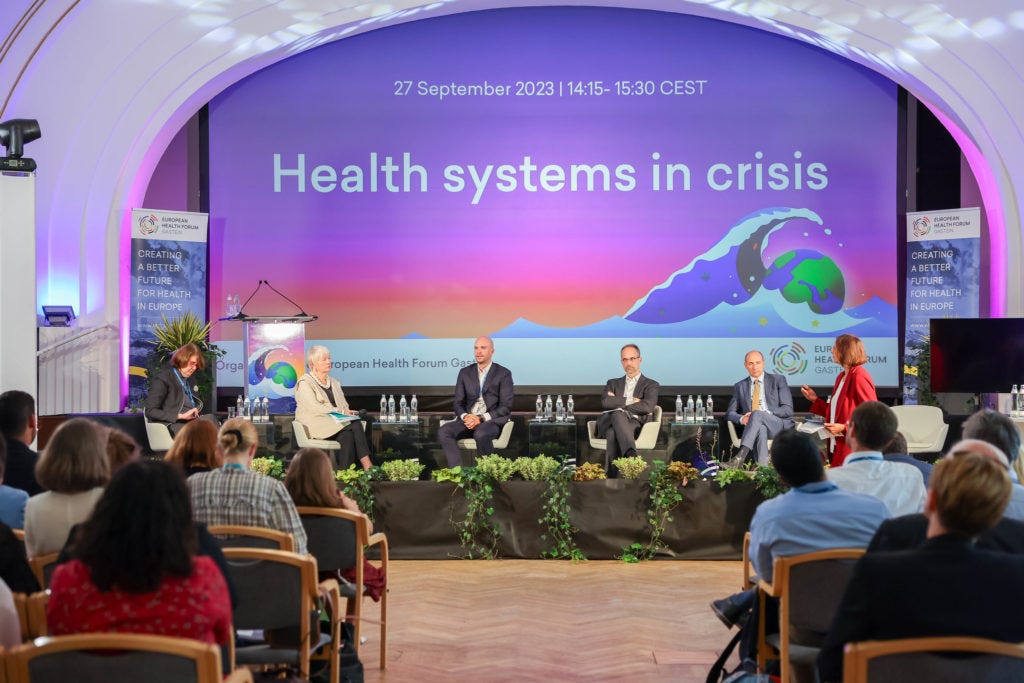
Europe Is Struggling To Keep Its Health Systems Afloat — Health Policy Watch
Europe’s health systems are facing a perfect storm of challenges, with a post-COVID budget crunch, ageing population and health workforce crisis threatening long-term stability.
Health Policy Watch
Stefan Anderson
28/09/2023
BAD HOFGASTEIN, Austria — European health systems, among the best-funded and most equitable in the world, face a barrage of threats to their long-term stability, highlighting the difficulty of achieving and maintaining universal health coverage even in the world’s wealthiest regions.
Experts and political leaders from across the World Health Organization’s (WHO) European region are gathered at the annual European Health Forum meeting in the idyllic resort town of Bad Hofgastein, Austria, this week to debate how to navigate Europe through the labyrinth of threats to the universal health care enjoyed by most of its citizens.
A rapidly ageing population, growing healthcare worker shortages, underinvestment in health systems and external shocks such as climate change and inflation driven by the Russian invasion of Ukraine are putting Europe’s healthcare systems through a battery of stress tests as the bloc looks to move on from the COVID-19 pandemic.
The threats faced by health systems of the European Union are shared across the WHO European region, which includes non-EU Scandinavian countries, Switzerland, the United Kingdom, Turkey, Russia and former Soviet Republics.
“The time is ticking on climate, the time is ticking on demographics, but on sustainability in economic terms,” said Sandra Gallina, Director General for Health and Food Safety at the European Commission. “We are talking about very sophisticated [health] systems … now we need to somehow make them sustainable.”
We are talking about very sophisticated [health] systems … now we need to somehow make them sustainable.”
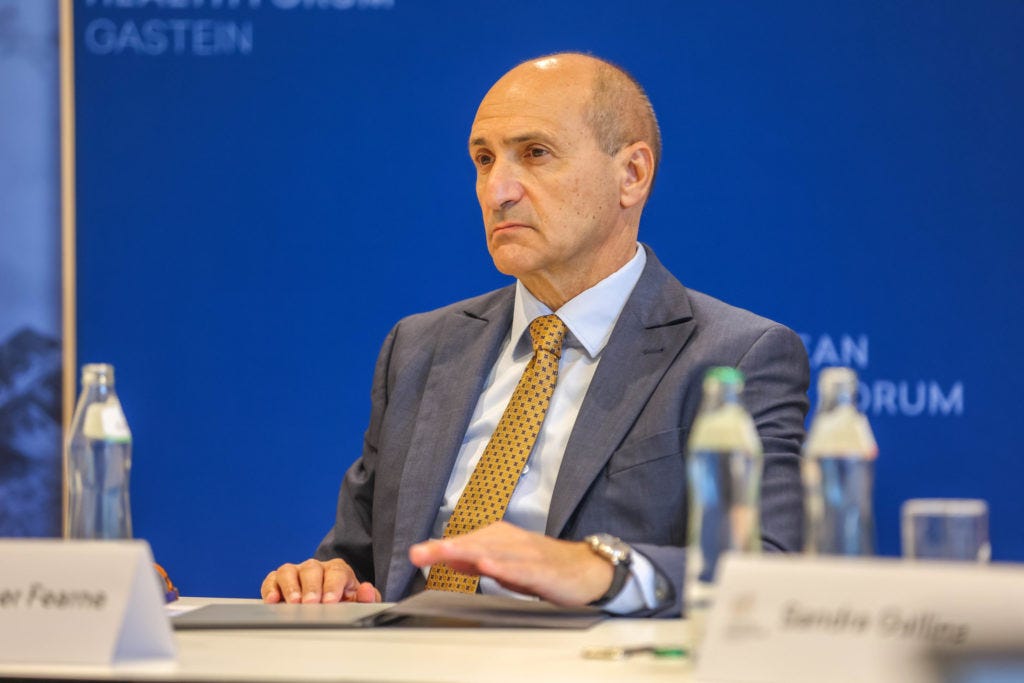
Post-COVID budget crunch threatens health systems
The European Union is moving on from the COVID era, but the end of crisis legislation is threatening to create a new set of crises of its own.
During the COVID-19 emergency, EU countries were granted the flexibility to spend beyond the 3.5% annual budget spending deficit mandated by the bloc, allowing countries with strong and weak healthcare systems alike to spend as they saw fit to respond to the virus.
That leniency is set to end on December 31, 2023, and as governments face massive cuts to overall public spending, health is likely to be one of the first items on the chopping block.
“Coupled with inflation and shrinking economies, governments have much less to spend and will have much less leeway with the budgets than they have now,” said Christopher Fearne, deputy prime minister of Malta and Europe’s longest-serving health minister. “The biggest victim of all of this could very well be health.”
Fearne is one of many European Union health ministers who will need to cut back on health spending if the bloc’s rigid budgetary rules are put back in place come January.
“The budgets member states will present to the [EU] Commission in October of this year are already starting to reflect this,” said Fearne. “Government spending will have to come down drastically, and of course, health is going to be one of the spheres which will be impacted.”
But Fearne and his fellow ministers argue there is a clear solution: count health as an investment, not a cost against national budgets.
“We need to look at this question of whether health spending should be reflected in the national budgets — at the moment, it is,” said Fearne. “This means next year governments are going to be very, very, very, very tight with spending.”
Government budget cuts are poised to deliver a shock to the health sector, which is already grappling with the new costs of climate change and the ongoing cost-of-living crisis. Efforts to decarbonize national health systems are also likely to be deprioritized as governments triage increasingly scarce funding.
Health experts warn that the cuts could have a devastating impact on the quality of care for Europeans. Longer wait times, reduced access to services, and a decline in the quality of care are all likely consequences of the cuts.
If public spending on health across the bloc falls, Fearne warned, the door will be left open for private industry to step into the vacuum in Europe’s health sector, with unpredictable results.
The EU health budget passed in 2021 earmarked a record €5.4 billion for spending on health — 11 times the amount apportioned in the previous budget for the 2014–2020 period.

Budgets still consider health a cost, not an investment
In principle, European Commission officials such as Gallina agree with the notion of health as an investment.
“
People started to believe a bit more in the words ‘investing in health’: that health is not a cost, but is an investment,” Gallina said, discussing the evolving attitudes of EU officials during the COVID-19 crisis. “Now, not all believe in it, but I believe that [among] a fair share of the actors around me, meaning the people that in the end decide … there was a paradigm shift.”
However, Gallina was more measured in her response to concerns about the pressure on the budget of smaller EU member states raised by Fearne on Wednesday, clarifying that “no promises” could be made that health might be exempted from the budget crunch.
“
Budget discipline is budget discipline,” Gallina said. “The only gloomy part I have in my toolbox is that I need to find sustainability soon, meaning economic viability which is good for the budgets of member states.”
Gallina added that Europe needs to find a way to balance the need for financial sustainability while maintaining the high-quality public health system that is, and should remain, a key pillar of the EU’s identity. She held up the heavily privatized healthcare system in the United States, which she had just visited after attending the United Nations General Assembly in New York City last week, as an example of what she does not want for Europe.
“
Europe is a good place and we need to protect it,” she said. “We need to not let it erode and arrive at a different reality which is not Europe.”
Dr Hans Kluge, director of the World Health Organization’s European Region, warned that the historic rise in economic inequality amid record profits for private corporations is undermining the resilience of health systems in Europe and around the world.
“We have never seen that extreme poverty and extreme wealth have risen simultaneously and sharply,” said Kluge. “We see giant corporations paying almost no, or few taxes, having unimaginable benefits, while for the first time in recent history, we have more and more children going to bed in the evening with a hungry stomach in the richest countries in our region.”
“
Our region is not the disaster-resilient region it used to be,” he said.
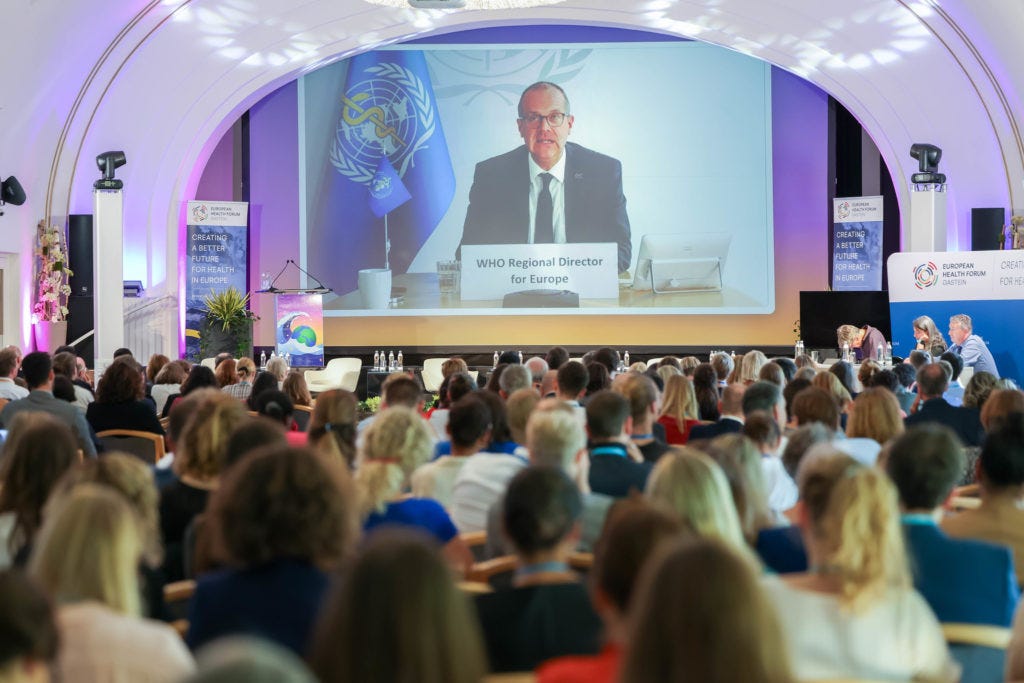
Europe’s health workforce crisis: a ‘ticking time bomb’
Despite having more doctors, nurses, and primary care workers than ever before, Europe faces a paradox: the shortage of health workers is growing, is larger than it has been in decades, and is still worsening.
Today, the World Health Organization’s 53-member European region is short an estimated 1.8 million health workers. That number is expected to climb to 4 million by 2030 if nothing is done to correct its course.
“The number one problem is the health worker crisis we have here in Europe because there is no health without the health workforce,” said Kluge. “We are facing a ticking time bomb.”
The COVID-19 pandemic exposed and exacerbated the deep-rooted problems facing Europe’s health workforce. Burnout, low pay, and dangerous working conditions are driving healthcare workers away from hospitals across the continent in droves.
Around 40% of healthcare workers are grappling with depression and anxiety, while 70% report feeling burned out, according to the ‘Time to Act’ WHO Europe report published last year.
Attrition rates among health workers are climbing, and as they do, more stress is placed on those who stay.
“
Some steps have been taken, but not enough has been done,” said Alvaro Cerame, chairperson for the Medical Workforce Committee of the European Junior Doctors Association. “We need to be a political priority.”
Nearly 50,000 European health workers lost their lives to COVID-19. Those who survived the pandemic continue to struggle through high burdens from mental health, physical exhaustion, and the death of colleagues — from COVID or suicide — which make remaining on the frontlines unbearable for many.
“
Let’s remember these are the brave souls who saved society on the frontline of the pandemic,” said Kluge. “The health providers I meet, they love what they do.”
“
It is not a job, It’s a vocation,” he said. “The people leaving the workforce simply have no choice, and the despair I see is — truly, as a medical doctor myself — really heartbreaking.”
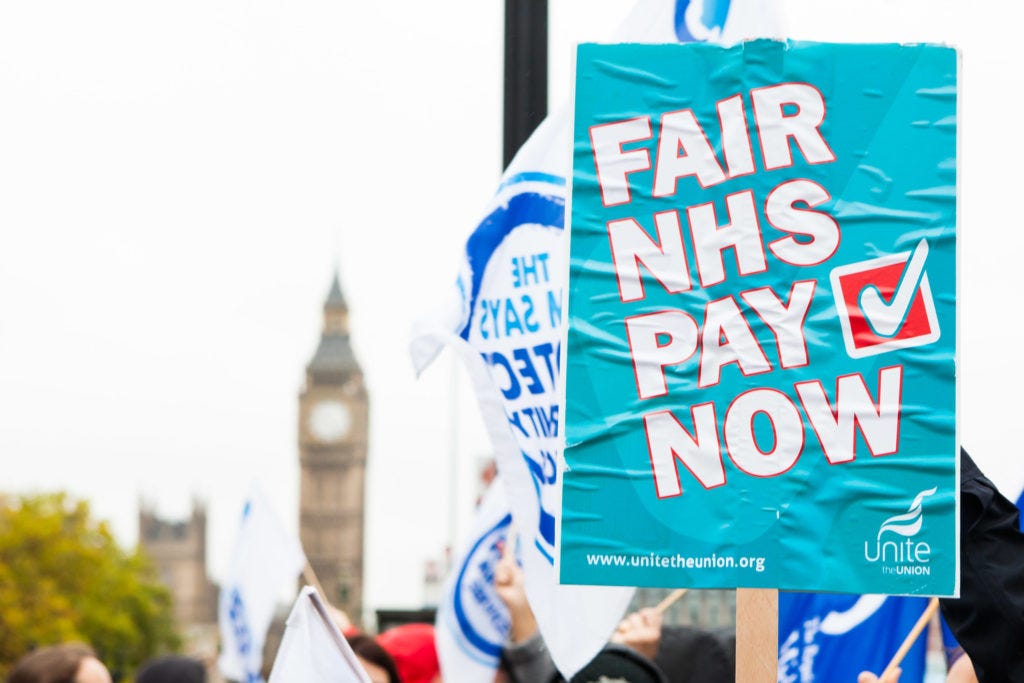
UK health worker strikes are a warning shot
Subpar pay and hazardous working conditions have sparked healthcare worker strikes across Europe. The ongoing strikes in the United Kingdom, which have snowballed into an uncontrollable crisis that just passed the bleak milestone of one million cancelled medical appointments, are a warning to other European countries of the consequences of neglecting their health workforce.
“There are strikes that then create huge issues, but it is not the moment of the strike that is important — it’s the long-term vision of where you get the staff and how we deal with staff shortages,” said Sandra Gallina, the European Commission’s acting director-general for health. “We need to be better at planning and forecasting needs for the workforce.”
Europe’s doctors are also ageing out of work at an alarming rate, and the continent is not churning out enough new doctors to replace them. On average, 30% of doctors in Europe are over 55, and in 13 countries, at least 40% of doctors are over 55 and will retire within the next decade. Italy has the oldest medical workforce in Europe, with nearly 60% of doctors over the age of 55.
If more people in the health workforce today leave, the gap will grow into a gulf, with potentially disastrous consequences for healthcare quality and access.
“
We need first to focus on retaining the health workers we already have because it takes a long time to produce more,” said Kluge. “So let’s retain and motivate the people we have by improving their working conditions and making the profession more attractive.”
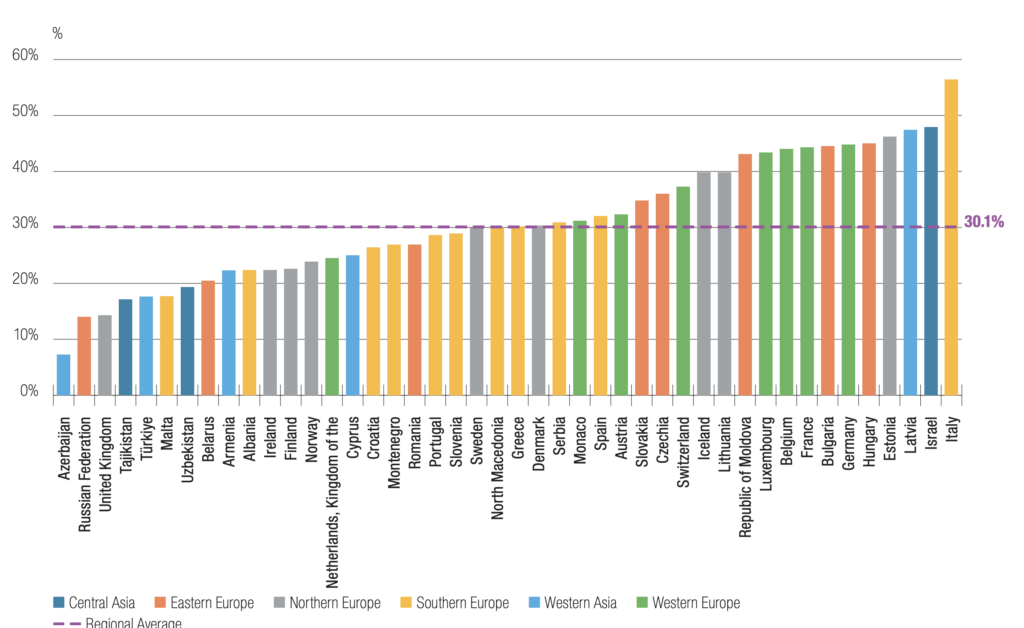
Europe’s Aging Population: A Challenge for Healthcare
Beyond Europe’s ageing doctors lies a more fundamental problem: a rapidly ageing population. As people live longer, they are more likely to develop chronic diseases, which can put a strain on healthcare resources.
The demographic shift has already prompted many European countries, including France, to raise the retirement age in order to correct budgetary imbalances that emerge when too few working people support a system of socialized healthcare and pension benefits.
While Europe’s demographic evolution towards an older society is inevitable, the solution over the long term, experts say, must be to reduce the pressure created by avoidable demands on the healthcare system in the first place. That means ensuring that more people enjoy more “healthy life years” through middle age and as they grow older.
This can be achieved through promoting health literacy and proactively combating avoidable health problems like obesity through education and awareness-raising, as well as tax, environment, and food policies that enable healthier choices and lifestyles.
“
Expecting to turn a big tanker of more than 500 million people fast is not fair,” said Gallina. “[But] where we want to arrive is a future that is sustainable for everybody, where is no inequality within countries or within member states.”
Originally published at https://healthpolicy-watch.news on September 28, 2023.
Image Credits: EHFG, Chris Marchmant.
Names mentioned
Here are the names mentioned in the article and their respective affiliations:
- Stefan Anderson: The author of the article who wrote it for Health Policy Watch.
- Sandra Gallina: Director General for Health and Food Safety at the European Commission. She discusses the need for sustainability in healthcare systems.
- Christopher Fearne: Malta’s Deputy Prime Minister and Health Minister. He was also the President of the 73rd World Health Assembly and talks about the impact of budget cuts on health spending.
- Dr. Hans Kluge: Director of the World Health Organization’s European Region. He highlights economic inequality and its effects on health systems.
- Alvaro Cerame: Chairperson for the Medical Workforce Committee of the European Junior Doctors Association. He emphasizes the need for healthcare workforce planning.




